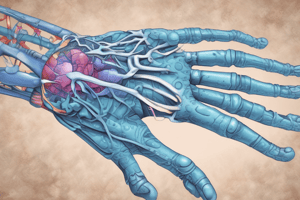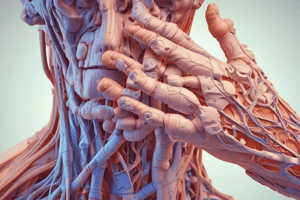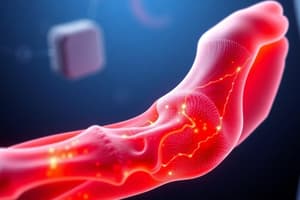Podcast
Questions and Answers
Which of the following is NOT a typical clinical indication for using glucocorticoids?
Which of the following is NOT a typical clinical indication for using glucocorticoids?
- Acute flare-ups in rheumatoid arthritis
- Inducing remission in autoimmune diseases
- Long-term management of osteoarthritis (correct)
- Systemic lupus erythematosus (SLE)
A patient with rheumatoid arthritis is prescribed methotrexate. Which of the following instructions should be emphasized to the patient regarding the administration and potential side effects of this medication?
A patient with rheumatoid arthritis is prescribed methotrexate. Which of the following instructions should be emphasized to the patient regarding the administration and potential side effects of this medication?
- Expect immediate pain relief upon starting the medication.
- Supplement with folic acid to reduce the risk of certain side effects. (correct)
- Discontinue the medication immediately if any side effects occur.
- Take the medication on an empty stomach to enhance absorption.
A patient with rheumatoid arthritis is prescribed leflunomide. Which statement is MOST important to communicate regarding side effects?
A patient with rheumatoid arthritis is prescribed leflunomide. Which statement is MOST important to communicate regarding side effects?
- Alopecia will be permanent.
- Hepatotoxicity is unlikely.
- Teriflunomide, its active metabolite, can cause diarrhea. (correct)
- Leflunomide is safe to use during pregnancy.
Which of the following is a primary mechanism of action of hydroxychloroquine in treating rheumatoid arthritis?
Which of the following is a primary mechanism of action of hydroxychloroquine in treating rheumatoid arthritis?
A patient is prescribed hydroxychloroquine for rheumatoid arthritis. Which of the following is the MOST critical monitoring parameter?
A patient is prescribed hydroxychloroquine for rheumatoid arthritis. Which of the following is the MOST critical monitoring parameter?
Gold salts have the capability of slowing down disease progression of joint erosion by affecting:
Gold salts have the capability of slowing down disease progression of joint erosion by affecting:
A patient with rheumatoid arthritis is considering starting on etanercept. What is the MOST important potential side effect to discuss?
A patient with rheumatoid arthritis is considering starting on etanercept. What is the MOST important potential side effect to discuss?
Which of the following is the primary mechanism of action of anakinra?
Which of the following is the primary mechanism of action of anakinra?
A patient with rheumatoid arthritis has a contraindication to methotrexate. Which of the following would be the MOST appropriate alternative DMARD to consider?
A patient with rheumatoid arthritis has a contraindication to methotrexate. Which of the following would be the MOST appropriate alternative DMARD to consider?
Why is early treatment with DMARDs crucial in rheumatoid arthritis?
Why is early treatment with DMARDs crucial in rheumatoid arthritis?
A patient has been taking methotrexate for several years to manage their rheumatoid arthritis. They report that the drug seems to be less effective recently. Which of the following is the most appropriate action?
A patient has been taking methotrexate for several years to manage their rheumatoid arthritis. They report that the drug seems to be less effective recently. Which of the following is the most appropriate action?
A patient starting on methotrexate should be monitored for which of the following potential severe side effects?
A patient starting on methotrexate should be monitored for which of the following potential severe side effects?
A patient is being treated with a DMARD that inhibits dihydroorotate dehydrogenase, involved in pyrimidine synthesis. Which drug are they MOST likely taking?
A patient is being treated with a DMARD that inhibits dihydroorotate dehydrogenase, involved in pyrimidine synthesis. Which drug are they MOST likely taking?
Why is combination therapy often used in the treatment of rheumatoid arthritis?
Why is combination therapy often used in the treatment of rheumatoid arthritis?
Which statement about DMARDs is MOST accurate?
Which statement about DMARDs is MOST accurate?
Which of the following best describes the role of glucocorticosteroids in the treatment of autoimmune diseases?
Which of the following best describes the role of glucocorticosteroids in the treatment of autoimmune diseases?
Which of the following mechanisms describes how methotrexate impacts the immune system to treat rheumatoid arthritis?
Which of the following mechanisms describes how methotrexate impacts the immune system to treat rheumatoid arthritis?
A rheumatologist is deciding whether to prescribe a DMARD or a biological agent for a patient with rheumatoid arthritis. What factor would MOST likely lead them to choose a biological agent?
A rheumatologist is deciding whether to prescribe a DMARD or a biological agent for a patient with rheumatoid arthritis. What factor would MOST likely lead them to choose a biological agent?
A patient with both RA and a history of TB exposure is starting infliximab. What is the MOST important step to take before starting therapy?
A patient with both RA and a history of TB exposure is starting infliximab. What is the MOST important step to take before starting therapy?
A patient has been diagnosed with Rheumatoid Arthritis according to the American College of Rheumatology criteria. What MINIMUM number of criteria must be met to confirm the diagnosis?
A patient has been diagnosed with Rheumatoid Arthritis according to the American College of Rheumatology criteria. What MINIMUM number of criteria must be met to confirm the diagnosis?
Which of the following is the MOST accurate statement regarding joint destruction in Rheumatoid Arthritis?
Which of the following is the MOST accurate statement regarding joint destruction in Rheumatoid Arthritis?
A patient with Rheumatoid Arthritis asks why they are being prescribed multiple medications. What is the MOST appropriate response?
A patient with Rheumatoid Arthritis asks why they are being prescribed multiple medications. What is the MOST appropriate response?
A patient has been prescribed methotrexate as a first-line agent for Rheumatoid Arthritis. Which of the following is the MOST important consideration for a clinician to keep in mind?
A patient has been prescribed methotrexate as a first-line agent for Rheumatoid Arthritis. Which of the following is the MOST important consideration for a clinician to keep in mind?
A patient with a pre-existing blood dyscrasia is diagnosed with rheumatoid arthritis. Which of the following DMARDs would be CONTRAINDICATED for this patient?
A patient with a pre-existing blood dyscrasia is diagnosed with rheumatoid arthritis. Which of the following DMARDs would be CONTRAINDICATED for this patient?
Which of the following best describes the mechanism by which gold salts may alleviate symptoms of rheumatoid arthritis?
Which of the following best describes the mechanism by which gold salts may alleviate symptoms of rheumatoid arthritis?
A patient with rheumatoid arthritis experiences blurred vision after starting a new medication. Which of the following drugs is MOST likely responsible?
A patient with rheumatoid arthritis experiences blurred vision after starting a new medication. Which of the following drugs is MOST likely responsible?
A patient is prescribed sulfasalazine for their rheumatoid arthritis. The patient's doctor explains that the drug is a pro-drug. What does this mean?
A patient is prescribed sulfasalazine for their rheumatoid arthritis. The patient's doctor explains that the drug is a pro-drug. What does this mean?
A patient started on D-penicillamine develops aplastic anemia. What action should be taken?
A patient started on D-penicillamine develops aplastic anemia. What action should be taken?
Which of the following is the MOST important consideration when administering pegloticase?
Which of the following is the MOST important consideration when administering pegloticase?
Which of the following best describes the action of allopurinol? The drug works by:
Which of the following best describes the action of allopurinol? The drug works by:
Which statement best describes the mechanism of action of Rasburicase?
Which statement best describes the mechanism of action of Rasburicase?
What advice is MOST important to give a patient who is newly prescribed probenecid for gout?
What advice is MOST important to give a patient who is newly prescribed probenecid for gout?
Which of the following is a significant advantage of febuxostat over allopurinol?
Which of the following is a significant advantage of febuxostat over allopurinol?
A patient experiencing an acute gout flare-up has a history of peptic ulcer disease and cannot take NSAIDs. Which of the following would be the most appropriate alternative treatment?
A patient experiencing an acute gout flare-up has a history of peptic ulcer disease and cannot take NSAIDs. Which of the following would be the most appropriate alternative treatment?
Which of the following medications is traditionally used to treat acute gout attacks by disrupting microtubules?
Which of the following medications is traditionally used to treat acute gout attacks by disrupting microtubules?
What is a common side effect of colchicine at therapeutic doses.
What is a common side effect of colchicine at therapeutic doses.
Which of the following characterizes the pathophysiology of gout?
Which of the following characterizes the pathophysiology of gout?
Which of the following can lead to secondary hyperuricemia?
Which of the following can lead to secondary hyperuricemia?
What is the most common initial presentation of symptoms in men suffering from clinical gout?
What is the most common initial presentation of symptoms in men suffering from clinical gout?
What is one effect of uric acid crystals leading to a severe infammatory response?
What is one effect of uric acid crystals leading to a severe infammatory response?
Flashcards
Rheumatoid Arthritis (RA)
Rheumatoid Arthritis (RA)
A chronic systemic inflammatory disease where the body mistakenly attacks its own joint tissues.
Disease-Modifying Anti-Rheumatic Drugs
Disease-Modifying Anti-Rheumatic Drugs
A class of medications used to slow down the progression of joint erosion in rheumatoid arthritis.
DMARD Mechanism of Action
DMARD Mechanism of Action
Suppress the proliferation and activity of lymphocytes and polymorph-nuclear leukocytes.
Methotrexate
Methotrexate
Signup and view all the flashcards
Methotrexate Mechanism
Methotrexate Mechanism
Signup and view all the flashcards
Methotrexate Contraindications
Methotrexate Contraindications
Signup and view all the flashcards
Methotrexate Side Effects
Methotrexate Side Effects
Signup and view all the flashcards
Leflunomide
Leflunomide
Signup and view all the flashcards
Leflunomide Mechanism
Leflunomide Mechanism
Signup and view all the flashcards
Leflunomide Side Effects
Leflunomide Side Effects
Signup and view all the flashcards
Chloroquine and Hydroxychloroquine
Chloroquine and Hydroxychloroquine
Signup and view all the flashcards
Chloroquine/Hydroxychloroquine: Side Effects
Chloroquine/Hydroxychloroquine: Side Effects
Signup and view all the flashcards
Glucocorticoids
Glucocorticoids
Signup and view all the flashcards
Sulfasalazine
Sulfasalazine
Signup and view all the flashcards
Gold Salts
Gold Salts
Signup and view all the flashcards
Gold Salts: Side effects
Gold Salts: Side effects
Signup and view all the flashcards
D-Penicillamine
D-Penicillamine
Signup and view all the flashcards
Tumor Necrosis Factor alpha (TNFa inhibitors)
Tumor Necrosis Factor alpha (TNFa inhibitors)
Signup and view all the flashcards
Severe infections, lymphomas
Severe infections, lymphomas
Signup and view all the flashcards
Anakinra
Anakinra
Signup and view all the flashcards
Abatacept
Abatacept
Signup and view all the flashcards
Gout
Gout
Signup and view all the flashcards
Uric Acid
Uric Acid
Signup and view all the flashcards
Tophi
Tophi
Signup and view all the flashcards
Drugs that may cause secondary hyperuricemia.
Drugs that may cause secondary hyperuricemia.
Signup and view all the flashcards
Drugs that may cause increased urate production
Drugs that may cause increased urate production
Signup and view all the flashcards
Drugs that may cause Decreased Renal Excretion of Urate
Drugs that may cause Decreased Renal Excretion of Urate
Signup and view all the flashcards
Clinical Features Peak
Clinical Features Peak
Signup and view all the flashcards
Probenecid and lesinurad
Probenecid and lesinurad
Signup and view all the flashcards
Allopurinol
Allopurinol
Signup and view all the flashcards
Probenecid
Probenecid
Signup and view all the flashcards
Aspirin and salicylates
Aspirin and salicylates
Signup and view all the flashcards
Allopurinol, MOA
Allopurinol, MOA
Signup and view all the flashcards
Febuxostat
Febuxostat
Signup and view all the flashcards
Pegloticase
Pegloticase
Signup and view all the flashcards
Rasburicase
Rasburicase
Signup and view all the flashcards
Colchicine
Colchicine
Signup and view all the flashcards
Colchicine Adverse Effects
Colchicine Adverse Effects
Signup and view all the flashcards
Indomethacin
Indomethacin
Signup and view all the flashcards
Study Notes
Learning Outcomes for DMARDs
- Describe mechanisms of action and roles of anti-rheumatic drugs (methotrexate, leflunomide, hydroxychloroquine, gold salts) in treating rheumatic conditions
- List indications and main side effects of these drugs
- Describe the roles of glucocorticosteroids in autoimmune diseases
- Describe unwanted effects of long-term glucocorticoid use and prevention
- Identify and describe the mechanism of action of immune modulators (etanercept, infliximab, adalimumab, anakinra) and their indications and side effects
Rheumatoid Arthritis (RA)
- RA is a chronic systemic inflammatory disease with unknown cause
- Usually presents as bilateral symmetric polyarthritis affecting hands and feet
- Any joint lined by a synovial membrane can be affected
- Extra-articular involvement of organs like skin, heart, lungs, and eyes can be significant
Rheumatoid Arthritis: Diagnosis
- The American College of Rheumatology requires at least four of the following criteria to confirm RA:
- Arthritis of hand joints for at least six weeks
- Arthritis on both sides of the body for at least six weeks
- Rheumatoid nodules under the skin
- Rheumatoid factor in blood testing
- Morning stiffness around the joint lasting at least one hour
- Arthritis of three or more joints for at least six weeks
- Evidence of rheumatoid arthritis on X-rays
Treatment of Rheumatoid Arthritis
- Joint destruction occurs early
- Begin DMARDs on diagnosis
- Combinations of drugs may be used
- The first and second years are critical
DMARDs for RA
- First-line agents: methotrexate and leflunomide
- Second-line agents: chloroquine, hydroxychloroquine, glucocorticosteroids
- Third-line agents: sulfasalazine, gold compounds, D-Penicillamine
- Biological agents: TNF inhibitors and others (immunomodulators)
DMARDs Mechanisms
- Act by various mechanisms to suppress proliferation and activity of lymphocytes and polymorph-nuclear leukocytes
- Counteract their ability to cause joint inflammation and destruction
- Joint erosion is usually found within 2 years of RA
- DMARDs should be prescribed at the time of diagnosis
Important Considerations for DMARDs
- Toxicity
- Loss of efficacy with time
- Anti-rheumatic drugs slow down disease progression
- Steroids suppress the immune system, but not disease progression
- NSAIDs suppress inflammation, but not disease progression
- Moderate inhibition of joint destruction occurs with drugs like sulphasalazine, hydroxychloroquine, or cyclosporin
- Delayed onset of action, requiring weeks to months to observe anti-rheumatic benefits
Traditional DMARDs
- Methotrexate
- Hydroxychloroquine
- Glucocorticosteroids
- Leflunomide
- Gold salts inhibit proliferation and activity of lymphocytes and polymorphonuclear leukocytes
- Capable of slowing down disease progression of joint erosion
Methotrexate
- Indications include rheumatoid arthritis, psoriasis, and as an antineoplastic agent
- Drug of choice for RA and still most effective
- More effective than other traditional DMARDs in limiting joint damage
- Start early, rapid dose escalation
- Significant toxicity reported in long-term treatment, causing 75% of patients to stop within 5 years
Methotrexate: Administration and Pharmacokinetics
- Well absorbed orally
- Plasma half-life of 8-10 hours
- Relatively rapid onset of action: 2-3 weeks
- Excreted unchanged in the urine; may accumulate in renal impairment
- Effective for up to 15 years
- More effective in combination with other DMARDs than as single-drug therapy
Methotrexate: Mechanism
- Anti-neoplastic and immune-modulating drug
- Several mechanisms exist:
- Inhibits folate reductase, reducing DNA synthesis
- Inhibits lymphocyte proliferation and production of cytokines and Rheumatoid Factor
- Inhibits leukocyte chemotaxis
- Decreases the production of free radicals and cytotoxins
Methotrexate: Contraindications
- Pre-existing blood dyscrasias
- Existing renal or hepatic impairment
- Previous or existing herpes or varicella infections
- Presence of a serous effusion (ascites or pleural effusion)
- Pregnancy and lactation
Methotrexate: Side Effects
- Hematologic: bone marrow suppression, megaloblastic anaemia (reversed with leucovorin)
- GIT: mucosal ulceration and bleeding, stomatitis, diarrhoea which may require stopping the drug
- Hepatotoxicity and pulmonary toxicity
- Folic acid supplementation is important
Leflunomide
- Alternative to methotrexate in treatment of RA
- Clinical indications include:
- Rheumatoid arthritis in adults
- Systemic lupus erythematosus (SLE)
Leflunomide: Mechanism
- Potent inhibition of leukocyte and T-cell proliferation
- Active metabolite (teriflunomide) prevents DNA, RNA, and protein synthesis in immune cells
- Inhibits dihydroorotate dehydrogenase, which is involved in pyrimidine synthesis
- Anti-proliferative effect on T cells provides anti-inflammatory action by reducing pro-inflammatory cytokines like IL-1 and TNF
- As effective as sulphasalazine and MTX
- Concern over possible hepatotoxicity
Leflunomide: Side Effects
- Diarrhoea
- Alopecia (reversible)
- Hepatotoxicity
- Inhibits CYP450, causing drug interactions
- Teratogenic- avoid in pregnancy
Chloroquine and Hydroxychloroquine
- Clinical indications include:
- Rheumatoid arthritis
- Systemic lupus erythematosus
Chloroquine and Hydroxychloroquine: Mechanisms
- Inhibits lymphocytes
- Stabilizes lysosomal membranes
- Reduces chemotaxis and phagocytosis of PMN
- Reduces production of superoxide radicals
- Slow onset of action: 6 months
Chloroquine and Hydroxychloroquine: Side Effects
- Ocular side effects:
- Blurred vision
- Scotomas
- Night blindness
- Photosensitivity
- Six monthly ophthalmologist follow-up is important
- Doesn't generally produce myelosuppression, hepatic and renal toxicity
Glucocorticoids
- Suppress the activation of T lymphocytes
- Suppress the production of cytokines by activated helper T cells
- Cytokines play a major role in inflammation
- Decrease the release of various chemical mediators of inflammation
- Stabilize lysosomal membranes of neutrophils and prevent the release of catabolic enzymes
- Cause vasoconstriction and decrease capillary permeability
Glucocorticoids (Example)
- Example: Prednisone
- Clinical indications include:
- RA and SLE
- Rapid onset (2-3 weeks)
- Used to induce remission and treat acute flare-ups
- Used as a low dose background therapy
Glucocorticoids: Side Effects
- Cushing's syndrome
- Hyperglycaemia
- Glucose intolerance
- Hypertension
- Osteoporosis
- Euphoria or psychosis
- Cataract
- Glaucoma
Sulphasalazine
- A pro-drug broken down to:
- Sulphapyridine (antibacterial and antirheumatic)
- 5-Aminosalicylic acid (anti-inflammatory)
- Indications:
- Ulcerative colitis
- Sulphapyridine is effective in RA, but the mechanism is unknown
Gold Salts
- Oral form: auranofin
- Parenteral forms: gold sodium thiomalate, aurothioglucose
- Indications include: rheumatoid arthritis
- Mechanism: unknown, but involves anti-mitochondrial activity and cell apoptosis
- Onset: 3-6 months
Gold Salts: Side Effects
- No longer a preferred drug due to its side effects:
- Hematologic
- Dermatologic
- GIT
- Renal
- Stomatitis
- 10% of patients develop membranous glomerulonephritis
- Orthostatic hypotension, bone marrow suppression, which lead to neutropenia and thrombocytopaenia
D-Penicillamine
- Chelating agent that modifies the formation of immunoglobulins (antibodies)
- Mechanism of action is not fully understood
- Reduces lymphocytes, inhibits macrophage action
- Reduces levels of inflammatory cytokines
- Onset of action: 3 months
- Side effects: aplastic anaemia, glomerulonephritis, toxic myopathy
Biologic Response Modulators
- These are also known as Immune modulators
Tumor Necrosis Factor Alpha (TNFα) Inhibitors
- Examples include: etanercept, infliximab, adalimumab
- Inhibit TNFα, which is a major pro-inflammatory cytokine that mediates the pathology of RA
- Proven efficacy in inhibiting radiologic progression of the disease
- Side effects: severe infections and lymphomas
Immune Modulators: Others
- Anakinra:
- A human Interleukin 1 receptor antagonist
- IL-1 is a major inflammatory cytokine that mediates cartilage degradation, bone resorption, and loss of peptidoglycans in RA
- Abatacept:
- Inhibits T-cell activation
- Has similar side effects as TNFα blockers
Gout
- A metabolic disease characterized by recurrent episodes of acute arthritis due to deposits of monosodium urate in joints and cartilage
Uric Acid
- End product of purine metabolism in humans
- Causes problems due to its limited solubility
- More soluble in alkaline urine
- Uric acid crystals LEAD to severe inflammatory response
- Tophi (chalky deposits) deposit in cool extremities (e.g. pinna of the ear, toes)
- Renal stones and/or renal tubular obstruction can also occur
Pathophysiology of Gout
- Uric acid precipitates in joints and kidneys
- Crystals are phagocytosed by cells
- The cells then release PG’s, IL-1 and lysosomal enzymes causing the pH of joint fluid to fall
- Leukocytes and phagocytes migrate to the joint and amplify inflammatory response
- Leukocytes release more mediators
Classification of Hyperuricemia
- Primary hyperuricaemia:
- Poor excretors of uric acid
- Over-producers of uric acid
- Secondary hyperuricaemia:
- Drugs (Loop and thiazide diuretics, ethambutol, pyrazinamide)
- Myeloproliferative disease
- Chronic renal failure
Increased Urate Production
- Nutritional factors include: excess purine, ethanol, and fructose consumption
- Hematologic conditions include: myeloproliferative and lymphoproliferative disorders, polycythaemia
- Drugs: Ethanol, cytotoxic drugs, vitamin B12 (treatment of pernicious anaemia)
- Miscellaneous: Obesity, psoriasis, hypertriglyceridemia
Decreased Renal Excretion of Urate
- Drugs: ethanol, cyclosporine, thiazides, furosemide and other loop diuretics, ethambutol, pyrazinamide, aspirin (low-dose), levodopa, nicotinic acid
- Renal: hypertension, polycystic kidney disease, chronic renal failure (any etiology)
- Metabolic/endocrine: dehydration, lactic acidosis, ketosis, hypothyroidism, hyperparathyroidism
- Miscellaneous: obesity, sarcoidosis, toxemia of pregnancy
Clinical Features of Gout
- Sudden pain, erythema, limited motion, swelling of the joint
- Peak occurrence: 30-50 years
- 90% of first attacks are monoarticular
- 50%+: first MTP joint initial joint involved = podagra
- MTP joint >instep/forefoot >ankle> knee> wrist> fingers
- In women: exclusively post-menopause
- Onset < 30 in men, premenopausal in women = atypical and can be associated with an inherited enzyme defect or renal disease
Drugs Preventing Gout Attack
- Prevented by drugs lowering uric acid
- Probenecid and lesinurad:
- Increase excretion of uric acid
- Allopurinol:
- Inhibit synthesis of uric acid
- Catabolic enzyme to reverse hyperuricemia
Uricosuric Drugs
- These drugs are used to prevent gout attacks in patients
- Used in patients that, under excrete uric acid, and have a 24-hr uric acid excretion < 800mg
Probenecid
- Probenecid is a weak acid
- Competitively inhibit the reabsorption of uric acid by renal tubules
- Administered orally
- Must drink a full glass of water to ensure adequate fluid intake
Probenecid Considerations
- Start slowly and gradually increase the dose
- Generally well-tolerated
- Drug-drug interactions:
- Aspirin and salicylates- interfere with the uricosuric effect, so avoid concomitant use
- High doses of salicylates have uricosuric effects
- Lesinurad- inhibits the functioning of the transporters
Xanthine Oxidase Inhibitors
- Used to treat gout by inhibiting xanthine oxidase
Allopurinol facts
- It is used to prevent gout attacks
- Used in individuals who overproduce uric acid
- Used to prevent hyperuricemia and gout
- Used in patients undergoing chemotherapy who have a high rate of purine catabolism
Allopurinol: MOA
- Decrease uric acid production
- Inhibits xanthine oxidase- an enzyme that converts hypoxanthine to xanthine and then xanthine to uric acid
- It is a competitive inhibitor of xanthine oxidase
Allopurinol other facts
- Causes a decrease in uric acid excretion
- Increase in the urinary excretion of hypoxanthine.
- Increase reutilisation of hypoxanthine and xanthine
- Inhibits nucleic acid synthesis
- Prevents the urate deposition
- Prevents the recurrence or progression of both gouty arthritis and nephropathy
Allopurinol pharmacokinetic
- Administered orally
- Rapidly converted into its active metabolite known as oxypurinol
- Oxypurinol has a plasma half-life of around 20 hours
- Mostly eliminated unchanged in the urine
Allopurinol Side Effects
- 25% of patients are unable to tolerate allopurinol
- Common side effects are nausea and vomiting
- Other side effects are hepatitis and skin rashes
Febuxostat
- First new drug to treat gout in less than 40 years
- It is a competitive inhibitor of xanthine oxidase
- Advantages over allopurinol:
- Once a day administration
- Greater efficacy
- More selective for xanthine oxidase than allopurinol
Febuxostat Side Effects
- Adverse effects are rare
- However reported effects consist of minor liver enzyme elevation, nausea, arthralgia, and rash
Catabolic Enzyme Agents
Pegloticase
- Recently approved for patients with refractory chronic gout
- Given as an intravenous infusion
- It is a recombinant uricase
Pegloticase MOA
- Catalysing the oxidation of uric acid to allantoin
- Allantoin- is an inert-water soluble purine metabolite that is renally excreted
- Administer under careful monitoring- increased risk of life-threatening allergic reaction
Rasburicase
- Recombinant uricase enzyme
- Indications
- Initial management of plasma uric acid levels in Paediatrics patients
- Is also used in Adults who are receiving chemotherapy
- Is commonly given for, Leukaemia, Lymphoma, and Solid tumour malignancies
Rasburicase and Chemotherapy
- Used for Chemotherapy induced Tumor lysis and cell death caused by ELEVATED URIC ACID LEVELS
Drugs for Treating Gout Attacks
Indomethacin
- It is a Non-steroidal anti-inflammatory drug
- Indications for gout
- Is a Potent anti-inflammatory used to relief pain
Colchicine
- Traditionally used to treat acute gout attach
Colchicine MOA
- Acts by disrupting microtubules
- Inhibit the motility of inflammatory leukocytes
- Blocking their ability to cause urate crystal-induced joint inflammation
Colchicine Pharmacokinetics
- Rapidly absorbed orally
- Partially metabolised in the liver
- Drug and its metabolite excreted via bile and faeces
Colchicine Effects
- Nausea and vomiting can occur
- Diarrhoea and abdominal cramps can occur
Colchicine other side effects -Therapeutic doses-
- Diarrhea, vomiting
- Abdominal pain
- Hair loss
- Hone marrow depression
- Peripheral neuropathy
Colchicine side effects -In overdose-
- Massive Gl damage
- Blood loss from Gl tract and shock
Corticosteroids in Gout
- Can be given Intra-articularly, intravenously, intramuscularly or orally.
- Indicated when one or two accessible joints are involved
- Before performing Intra-articular injection, one must ASPIRATE the joint for diagnosis and synovial fluid cultures to rule out contraindications for intra-articular steroid administration.
- Oral prednisone or Triamcinolone is common options if NSAIDs are contraindicated
Studying That Suits You
Use AI to generate personalized quizzes and flashcards to suit your learning preferences.




